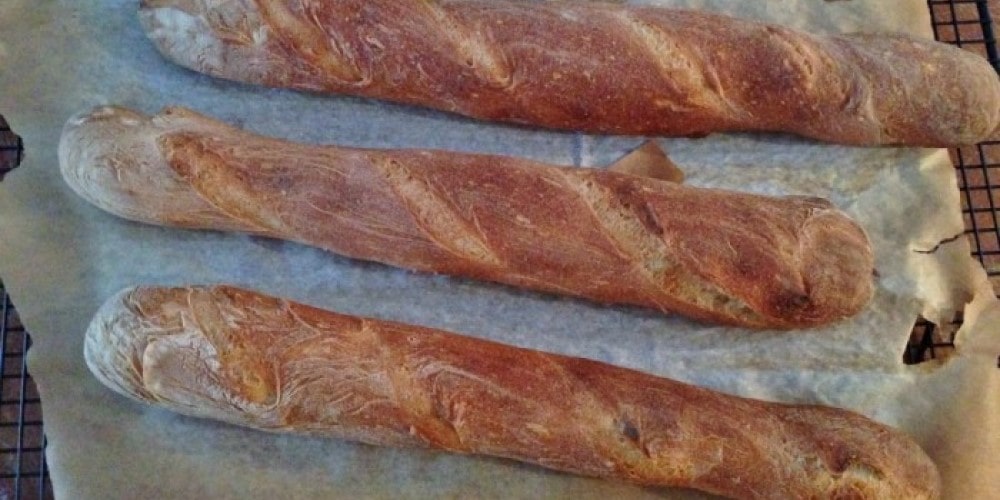
How to make 4-hour baguettes
Makes: 3 small baguettes
If you’re looking for something to do while it’s bitterly cold outside, here’s a 4-hour project with a delicious result! Sometimes I stumble across a recipe that just looks unbelievable enough (this can’t work, or taste good) to make me want to try it. Such was the case with the 4-hour baguette recipe I found on the Food52 website. Since I’m not a baker, especially of bread, this was even more laughable, but one Sunday I threw down the flour and yeast and went to work.
Ingredients
- 1 ½ cups (12 ounces) tap water, heated to 115°
- 1 teaspoon ( ⅛ ounce) active dry yeast
- ½ teaspoon sugar
- 3 ¼ cups (14 ⅔ ounces) all-purpose flour
- 2 teaspoons ( ⅜ ounces) Diamond Crystal kosher salt (note: if using a fine-grained salt like table salt, fine sea salt or other brands of kosher salt, you will need to use a smaller volume)
- Vegetable oil, for greasing bowl
- ½ cup ice cubes
Directions
1Whisk together water, yeast and sugar in a large bowl; let sit until yeast is foamy, about 10 minutes. Add flour, and stir with a fork until dough forms and all flour is absorbed; let dough sit to allow flour to hydrate, about 20 minutes. Add salt, then transfer dough to a lightly floured work surface, and knead until smooth and elastic, about 10 minutes. Transfer dough ball to a lightly greased bowl, cover bowl with plastic wrap, and place bowl in a cold oven or microwave. Let dough rest until doubled in size, about 45 minutes.
2Transfer dough to a lightly floured work surface, and shape into an 8-inch x 6-inch rectangle. Fold the 8-inch sides toward the middle, then fold the shorter sides toward the center, like a T-shirt. Return dough, seam side down, to the bowl. Cover with plastic again, and return to oven. Let sit until doubled in size, about 1 hour.
3Remove bowl with dough from oven and place a cast–iron skillet on the bottom rack of oven; position another rack above skillet, and place a baking stone or upside down or rimless sheet pan on it.
4Heat oven to 475° F. Transfer dough to a lightly floured work surface, and cut into three equal pieces; shape each piece into a 14-inch rope. Flour a sheet of parchment paper on a rimless baking sheet; place ropes, evenly spaced, on paper. Lift paper between ropes to form pleats; place two tightly rolled kitchen towels under long edges of paper, creating supports for the loaves. Cover loosely with plastic wrap; let sit until it doubles in size, about 50 minutes.
5Uncover; remove towels, and flatten paper to space out loaves. Using a sharp razor, knife, bread lame or scissors, slash the top of each baguette at a 30–degree angle in four spots; each slash should be about 4 inches long. Pull out the oven rack with the stone or baking sheet on it and, using the corner of the parchment paper as a guide, slide the loaves, still on the parchment paper, onto the baking stone or pan. Place ice cubes in skillet (this produces steam that lets the loaves rise fully before a crust forms). Bake the baguettes until darkly browned and crisp, 20 to 30 minutes; cool before serving.
My verdict: Amazing! While Maison Kayser has nothing to worry about (yet), these were everything you’d want a baguette to be—good flavour and a great crust. Much better than anything we can get locally. The texture of the bread itself needs a little work, and my slashes were barely noticeable (time to get a lame, my single edged razor blade wasn’t cutting it – literally), but I’m really nit-picking now. Frank paid them the ultimate compliment, saying “we’ve had worse baguettes in France.” I’m not sure how you would do this without the cast iron pan, ice and pizza stone combo – it sounds weird, but it works wonderfully! I added the sugar to the recipe, it makes the yeast work better, but it’s not essential.
About the author
Anne Maxfield is a New York based food influencer and blogger who dreams of making the South of France her home. When she’s not tracking down cheese or making her own charcuterie, she writes the Accidental Locavore blog and contributes to the Huffington Post. This article is adapted from a post on her blog.
Originally published on our sister site, France Today
Share to: Facebook Twitter LinkedIn Email
More in Baguettes, Bread, Flour, Recipe, Yeast




REPLY
REPLY
REPLY
REPLY